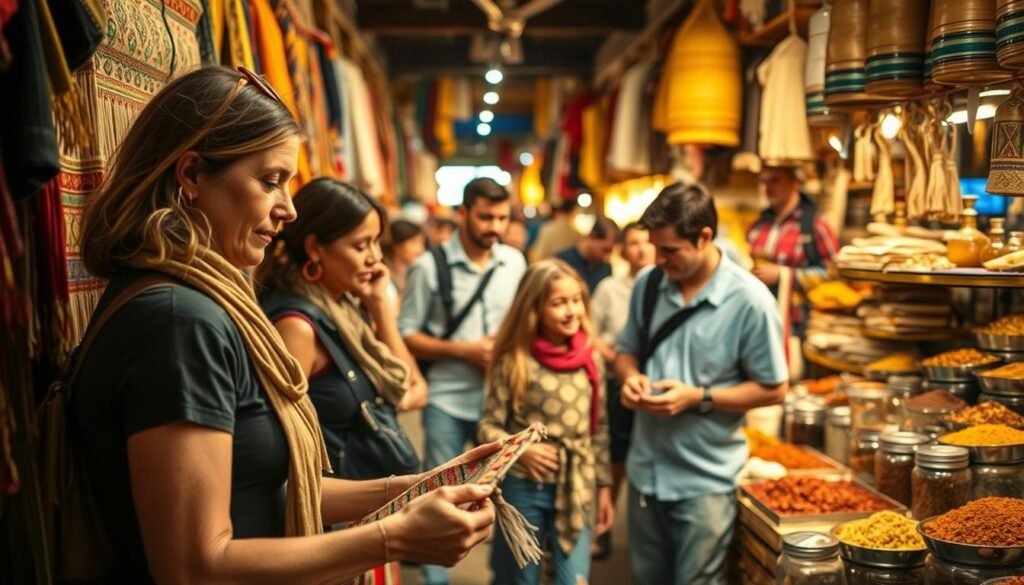Travel Storytelling Tips: Captivate Audiences
Imagine standing on a cliff, looking out at a stunning view. The sun is setting, making everything warm and beautiful. Moments like these inspire compelling stories. As a travel lover, you can share these moments with others.
Digital storytelling can make your online presence shine. By sharing your own stories and the beauty of places you’ve seen, you grab your audience’s attention. You also show you’re an expert in travel.
Key Takeaways
- Create engaging content by sharing personal experiences
- Use digital storytelling to enhance online visibility
- Establish credibility by sharing authentic stories
- Make your content more relatable and immersive
- Captivate your audience with compelling narratives
Understand Your Audience
The secret to great travel writing is knowing your audience well. You need to figure out who they are, what they like, and how they like to read about travel. This is key to writing stories that they will love.
Identify Their Interests
To really get to know your audience, talk to them directly and indirectly. Use social media interactions, comment sections on your blog, and surveys or feedback forms. By analyzing these, you can see what travel stories they find most exciting.
Do they love adventure travel, cultural experiences, or luxury travel? Knowing this helps you make content that they will enjoy. This way, you can keep them coming back for more.
Tailor the Storytelling Tips & Experience
After knowing what your audience likes, it’s time to make your stories special. Use vivid descriptions and personal anecdotes to make your stories come alive. This way, your readers will feel like they’re right there with you.
Also, think about how your audience likes to consume your stories. Do they prefer detailed blog posts, engaging videos, or captivating social media stories? Making your stories fit their preferred format can really boost their interest.
Craft a Compelling Narrative
To grab the audience’s attention, travel storytellers need to craft a compelling story. They must structure it in a way that keeps the audience hooked from start to finish.
Start with a Hook
The first step is to start with a hook that grabs the audience’s attention. This could be an interesting fact, a personal story, or a vivid description. It sets the tone for the rest of the story.
Using vivid imagery and emotive language can make a strong hook. It draws the audience in.
Build Up to a Climax
Once the audience is hooked, the story should build up to a climax. This involves creating a flow that keeps the audience interested. Often, this means introducing challenges or conflicts that are later solved.
The use of descriptive storytelling helps build up to the climax. It makes the story more immersive and engaging.
Conclude with Reflection
Lastly, conclude the story with reflection. This adds depth and gives the audience a takeaway. It makes the story more memorable.
By adding personal reflections and insights from the travel, storytellers leave a lasting impression. They connect with their audience on a deeper level.
Use Vivid Descriptions
In travel storytelling, vivid descriptions are key to engaging readers. Vivid descriptions bring travel stories to life, making places feel real to readers.
Engage the Senses
To write compelling travel stories, it’s important to engage the senses. Describe what you saw, heard, smelled, tasted, and felt on your travels. For example, instead of saying “the market was vibrant,” describe the cacophony of sounds, the array of colors, and the intoxicating aromas.
As a travel writer,
“The world is a book, and those who do not travel read only one page.”
This quote by Saint Augustine shows why experiencing different cultures is vital. It’s essential for creating vivid travel stories.
Paint Pictures with Words
Creating vivid images with words is an art. It’s about choosing descriptive language that paints a picture in the reader’s mind. For instance, describing a serene beach at sunset might include the warm hues of the sky, the gentle lapping of waves, and the peaceful ambiance.
- Use metaphors and similes for vivid comparisons.
- Add sensory details to make the story richer.
- Avoid clichés and overused descriptions.
By mastering vivid descriptions, travel writers can take readers on journeys. They evoke emotions and inspire a desire to explore.
Incorporate Personal Experiences
Travel stories get better when you add your own experiences. Sharing your adventures makes your tales relatable and unforgettable. It helps you connect with your readers on a deeper level.
Share Unique Moments
Every trip has special moments. These can be stunning views or unexpected cultural experiences. It’s key to capture the emotional essence of these moments. Share how they made you feel and why they mattered.
For example, telling about a peaceful sunrise over a lake can calm your readers. Use detailed descriptions to bring these moments to life. This way, you draw your audience into your story.
Include Relevant Anecdotes
Anecdotes add depth to your travel stories. They can share cultural insights, show personal growth, or entertain. Make sure they fit well with your story and keep it flowing smoothly.
To use anecdotes well, consider the following table. It shows what makes anecdotes great in travel stories:
| Characteristic | Description | Example |
|---|---|---|
| Relevance | Anecdotes should be relevant to the travel story | A story about trying local cuisine |
| Emotional Connection | Anecdotes should evoke emotions in the reader | A heartfelt story about a cultural encounter |
| Brevity | Anecdotes should be concise and to the point | A brief tale of a misadventure |
By adding personal experiences, unique moments, and relevant anecdotes, you can improve your storytelling. This method makes your stories more engaging. It also helps in creating memorable travel stories that touch your audience’s hearts.
Use Visual Storytelling
Visual storytelling can take people on virtual trips, making travel feel real and exciting.
It’s a key part of travel content, helping to share feelings and stories. With great visuals, stories come alive, sparking the desire for new adventures.
Leverage Photos and Videos
Photos and videos are vital for telling travel stories. They give a direct look at places, cultures, and experiences.
- High-Quality Photos: Choose clear images that show the heart of travel, from stunning views to lively events.
- Engaging Videos: Use videos to show the movement and life of travel, like city vibes or peaceful nature.
Balance Text and Visuals
Finding the right mix of text and visuals is key to keeping people interested. Too much text can be too much, while too many visuals can lose the story.
| Content Type | Purpose | Best Practices |
|---|---|---|
| Text | Give detailed stories and background | Keep it short, use headings for clarity |
| Visuals (Photos/Videos) | Make the story come alive, touch emotions | Choose top-notch visuals, match them to the story |
By using visual storytelling well, creators can make travel stories that both teach and inspire. This makes travel more inviting to more people.
Maintain Cultural Sensitivity
Travel storytelling is more than just telling stories. It’s about respecting the cultures we write about. As writers, we shape how people see different cultures.
Being culturally sensitive is key. It means we tell stories with respect and care for local customs. We must avoid stereotypes and misconceptions.
Respect Local Customs
Understanding and respecting local customs is vital. This means researching the culture and engaging with the community. It’s about being aware of cultural differences.
Some actions might be seen as offensive in certain cultures. Knowing these differences helps us avoid causing offense.
Key Considerations for Respecting Local Customs:
- Research local customs and traditions before writing about a destination.
- Engage with the local community to gain a deeper understanding of their culture.
- Be mindful of cultural differences and avoid making assumptions.
Avoid Stereotypes
Stereotypes harm and create negative views of cultures. Travel writers should focus on the unique aspects of a place. This way, they avoid stereotypes.
“The biggest adventure you can take is to live the life of your dreams.” – Oprah Winfrey. This quote shows the importance of cultural sensitivity, embracing cultures with an open heart and mind.
To avoid stereotypes, highlight the diversity within cultures. Don’t oversimplify complex issues. This way, we offer a more accurate view of the places we write about.
| Cultural Aspect | Stereotypical Representation | Nuanced Representation |
|---|---|---|
| Traditional Dress | Portraying traditional dress as exotic or primitive. | Describing the significance and history behind traditional attire. |
| Local Cuisine | Reducing local cuisine to a few well-known dishes. | Exploring the variety and regional differences in local cuisine. |

By being culturally sensitive and avoiding stereotypes, we create stories that engage and educate. These stories help people understand cultures in a respectful and nuanced way.
Encourage Interaction
Travel storytellers can make their stories more engaging by inviting the audience to join in. This creates a sense of community and helps improve content.
Ask Questions
Asking questions is a simple way to get people involved. It can be as easy as asking for tips or sharing personal stories related to the travel tale.
For example, after a blog post about a place, you could ask, “What’s your favorite thing to do there?” or “Have you had a similar adventure? Share it in the comments below.”
Engaging with your audience through questions helps in building a loyal community around your travel content.
Invite Feedback
Asking for feedback is another great way to get people talking. You can ask readers to share their thoughts on the story or suggest new topics.
A table summarizing the benefits of asking questions and inviting feedback is shown below:
| Strategy | Benefits |
|---|---|
| Asking Questions | Encourages audience participation, fosters community |
| Inviting Feedback | Provides valuable insights, improves content quality |
By using these strategies in your travel blog, you can make your content more engaging and dynamic.
Effective interaction is key to a successful travel blog, making the content more relatable and enjoyable.
Utilize Social Media Effectively
Travel storytelling gets a big boost from social media. It lets storytellers grab their audience’s attention, get them involved, and share their stories far and wide.
First off, picking the right social media sites is key. Each platform draws different people, so knowing where your audience hangs out is vital.
Choose the Right Platforms
For example, Instagram and YouTube are great for sharing stunning photos and videos. They take your viewers on virtual trips. But, Twitter and Facebook are better for quick updates, chatting with followers, and directing people to your blog or website.
Knowing what each platform does best helps storytellers craft their content to reach more people.
Post Regularly for Engagement
Posting often is important for keeping your audience hooked. It builds a loyal fan base. But, it’s also important to post quality content that adds to your story.
Using a content calendar helps plan and schedule posts. This keeps your content flowing smoothly. Also, talking back to your followers creates a community feel and makes your storytelling better.
By smartly using social media, travel storytellers can make their digital storytelling for travel more engaging. This approach is essential for storytelling in tourism marketing. It lets storytellers share their adventures and motivate others.
Create a Consistent Voice
A consistent voice in travel stories is key to building a strong brand. It makes a storyteller stand out. By keeping a steady tone and language, writers can build a brand that readers trust.
Creating a unique style is essential for this voice. It means using certain words, tones, and ways of telling stories that connect with readers. For example, some writers might be funny, while others dive deep into the culture of places they visit.
Develop a Unique Style
To find your unique style, start by thinking about what you’re good at and what you want to share. Reflect on your travels and what you find most exciting. Decide on the tone you want to use.
For adventure travel, writers might use exciting language and detailed descriptions. For cultural stories, they might take a more thoughtful approach, exploring the history and society of places they visit.
“The storyteller’s task is to create a world that the reader can enter and experience as if it were their own.” –
Stay Authentic Across Platforms
Being true to yourself on all platforms is vital. Today, writers often share their stories on social media, blogs, and videos. It’s important to keep your message, tone, and style the same everywhere.
| Platform | Content Style | Engagement Strategy |
|---|---|---|
| Visual storytelling with captions | Use hashtags, engage with followers through comments | |
| Blog | In-depth articles with personal anecdotes | Encourage comments, respond to feedback |
| YouTube | Video narratives with subtitles | Use video descriptions, engage through video comments |
By being true and consistent, writers can gain a loyal following. It’s not just about keeping a steady voice but also about sticking to your values and themes.

In conclusion, creating a consistent voice is complex. It requires a unique style and authenticity across platforms. By mastering these, writers can make their stories more engaging and relatable to their audience.
Experiment with Different Formats
Travel storytellers need to try out different content formats to see what works best. By mixing up how they share their stories, they can reach more people and get more engagement.
Travel storytellers can use blogs, vlogs, and podcasts to share their experiences. Each format has its own strengths in telling travel stories.
Use Blogs, Vlogs, and Podcasts
- Blogs let readers dive into stories at their own speed. They can enjoy the details of the journey.
- Vlogs or video blogs show the excitement of travel through video and personal stories. They’re lively and engaging.
- Podcasts let storytellers share their tales through sound. It’s a personal and easy way to connect with listeners.
Find What Resonates Best
The secret to success is to watch how your audience reacts and change your approach as needed. By looking at how people interact with your content, you can figure out what they like best.
Engaging travel content is about more than just the format. It’s about making sure the content fits what your audience wants to see and hear. Always be ready to try new things and adjust your strategy as the digital world changes.
Edit and Refine Your Content
To make your travel story hit home with your audience, refining it is key. This means checking your story for clarity and flow. Also, getting feedback can make it even more impactful.
Review for Clarity and Flow
When you review your travel story, focus on clarity and flow. Make sure your story is straightforward and your ideas are connected. A clear and flowing story keeps your audience hooked.
To make your story better, try these tips:
- Make complex sentences simpler for easier reading.
- Use transitional phrases to link your ideas smoothly.
- Remove words or phrases that don’t add to your story.
Seek Constructive Criticism
Getting constructive feedback is a must for improving your travel content. Feedback from others can show you how your story is seen and where you can get better. Good feedback can point out areas you might not see and make your story better.
| Benefits of Constructive Criticism | How to Implement Feedback |
|---|---|
| Identifies areas for improvement | Use feedback to refine your narrative and make it more engaging. |
| Enhances storytelling skills | Apply suggestions to improve your storytelling techniques. |
| Increases audience engagement | Adjust your content to better resonate with your target audience. |
By refining your content through review and feedback, you can greatly improve your storytelling skills for travelers. This makes your memorable travel stories even better. It’s all about making your narrative travel writing engaging, clear, and impactful.
Stay Inspired
To keep your travel stories fresh, it’s key to stay inspired. Follow other travel writers who share great stories. Use different writing styles and add pictures to your tales.
Discover New Voices
Follow travel writers on social media or their blogs. Seeing how they tell stories can inspire you. It might spark new ideas for your own writing.
Record Your Ideas
Keep a journal of your thoughts and ideas. Write down what you see and feel while traveling. This can help you find new ways to share your experiences.
By following these tips, you can keep your stories exciting and full of life. Your readers will love the vivid details and personal stories you share.













[…] Storytelling is key in volunteer travel. It inspires others and helps us understand the world better. By sharing their stories, volunteers can show the true essence of their journeys. […]